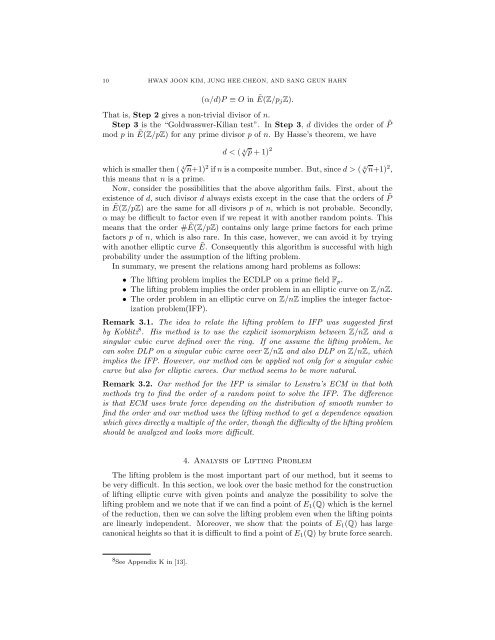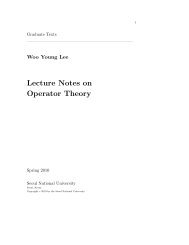ON REMARKS OF LIFTING PROBLEMS FOR ELLIPTIC CURVES 1 ...
ON REMARKS OF LIFTING PROBLEMS FOR ELLIPTIC CURVES 1 ...
ON REMARKS OF LIFTING PROBLEMS FOR ELLIPTIC CURVES 1 ...
You also want an ePaper? Increase the reach of your titles
YUMPU automatically turns print PDFs into web optimized ePapers that Google loves.
10 HWAN JO<strong>ON</strong> KIM, JUNG HEE CHE<strong>ON</strong>, AND SANG GEUN HAHN<br />
(α/d)P ≡ O in Ẽ(Z/p jZ).<br />
That is, Step 2 gives a non-trivial divisor of n.<br />
Step 3 is the “Goldwasswer-Kilian test”. In Step 3, d divides the order of ˜P<br />
mod p in Ẽ(Z/pZ) for any prime divisor p of n. By Hasse’s theorem, we have<br />
d < ( 4√ p + 1) 2<br />
which is smaller then ( 4√ n+1) 2 if n is a composite number. But, since d > ( 4√ n+1) 2 ,<br />
this means that n is a prime.<br />
Now, consider the possibilities that the above algorithm fails. First, about the<br />
existence of d, such divisor d always exists except in the case that the orders of ˜P<br />
in Ẽ(Z/pZ) are the same for all divisors p of n, which is not probable. Secondly,<br />
α may be difficult to factor even if we repeat it with another random points. This<br />
means that the order #Ẽ(Z/pZ) contains only large prime factors for each prime<br />
factors p of n, which is also rare. In this case, however, we can avoid it by trying<br />
with another elliptic curve Ẽ. Consequently this algorithm is successful with high<br />
probability under the assumption of the lifting problem.<br />
In summary, we present the relations among hard problems as follows:<br />
• The lifting problem implies the ECDLP on a prime field F p .<br />
• The lifting problem implies the order problem in an elliptic curve on Z/nZ.<br />
• The order problem in an elliptic curve on Z/nZ implies the integer factorization<br />
problem(IFP).<br />
Remark 3.1. The idea to relate the lifting problem to IFP was suggested first<br />
by Koblitz 8 . His method is to use the explicit isomorphism between Z/nZ and a<br />
singular cubic curve defined over the ring. If one assume the lifting problem, he<br />
can solve DLP on a singular cubic curve over Z/nZ and also DLP on Z/nZ, which<br />
implies the IFP. However, our method can be applied not only for a singular cubic<br />
curve but also for elliptic curves. Our method seems to be more natural.<br />
Remark 3.2. Our method for the IFP is similar to Lenstra’s ECM in that both<br />
methods try to find the order of a random point to solve the IFP. The difference<br />
is that ECM uses brute force depending on the distribution of smooth number to<br />
find the order and our method uses the lifting method to get a dependence equation<br />
which gives directly a multiple of the order, though the difficulty of the lifting problem<br />
should be analyzed and looks more difficult.<br />
4. Analysis of Lifting Problem<br />
The lifting problem is the most important part of our method, but it seems to<br />
be very difficult. In this section, we look over the basic method for the construction<br />
of lifting elliptic curve with given points and analyze the possibility to solve the<br />
lifting problem and we note that if we can find a point of E 1 (Q) which is the kernel<br />
of the reduction, then we can solve the lifting problem even when the lifting points<br />
are linearly independent. Moreover, we show that the points of E 1 (Q) has large<br />
canonical heights so that it is difficult to find a point of E 1 (Q) by brute force search.<br />
8 See Appendix K in [13].













